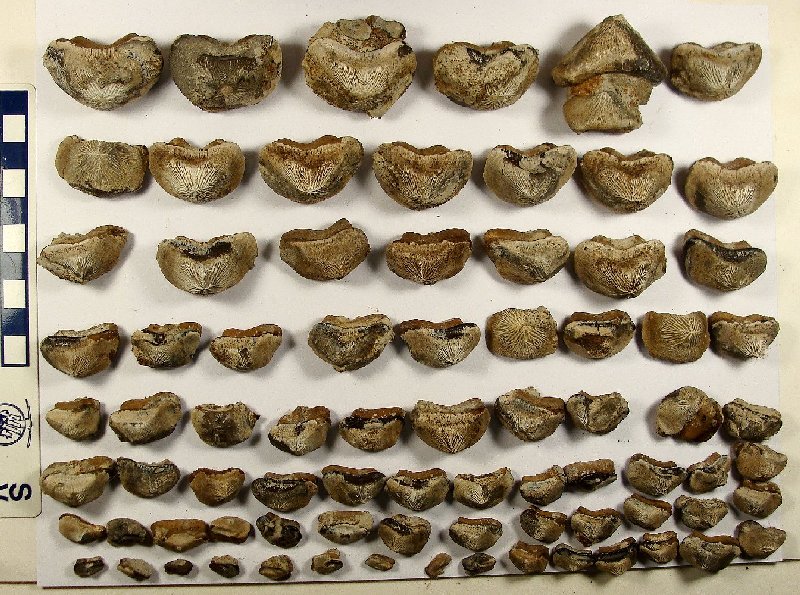 |
A new specimen of Ptychodus
mortoni
from the Smoky Hill Chalk of Kansas
Copyright © 2011-2013 by Mike Everhart
Created 10/27/2010 - Last updated 08/19/2013
LEFT:
Some of the more than 550 teeth Ptychodus mortoni (FHSM VP-17606)
teeth collected
in October, 2010, along with calcified cartilage, vertebrae and dermal
denticles. |
Ptychodus is a extinct genus of durophagous
(shell-crushing) sharks from the Late Cretaceous. Their isolated teeth have been
collected on all continents, including Australia, but their associated teeth
and jaw plates occur most often in the Smoky Hill Chalk deposited in the Western
Interior Sea of North America. As a group, Ptychodontids became extinct during
the middle Santonian of the Western Interior Sea around 85 million years ago, but
they persisted along the Gulf Coast and elsewhere into the early Campanian.
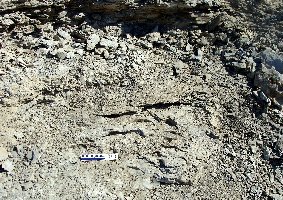 |
In October, 2010, I was contacted by Steve Mense, an amateur
collector who had discovered a large number of Ptychodus mortoni
teeth near the Smoky Hill River in eastern Logan County, Kansas. He had
already collected over 300 teeth but needed help in recovering the rest of
the specimen, so we made arrangements to meet at the locality. When I
arrived, he took me to the site and showed me where the teeth were
emerging from the edge of a gully.
LEFT: This is the edge of the excavation before we started.
Some teeth are barely visible in the center of the picture.
RIGHT: After we removed some of the overburden and loose teeth
around the edges, we reached an area where the teeth were all jumbled
together... and noticed some pieces of cartilage (dark brown). Everything
was covered with root mats and powdery gypsum, plus the unusually hard gray chalk was badly
fractured... not a good recipe for taking it out in a jacket. |
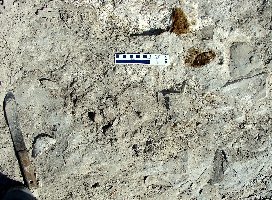 |
This layer of chalk between Hattin's Marker Unit 8 and 9 is
difficult to work with because it is harder than normal and does not come up in
nice, flat layers. After trying for a half hour or so to trench around the
specimen to get ready it ready for a jacket, it became apparent that all were
were doing was damaging it. Although I would have rather put a secure jacket
around it, we finally decided to take it up carefully in pieces. As it turned
out, nearly all of the large chunks of cartilage came up without breaking. Not
pretty but at least we weren't taking the risk of having it fall out of the
jacket in pieces when we turned it.
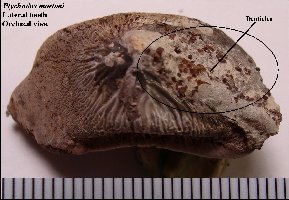 |
LEFT: One of the first things I noticed when
I started cleaning up the specimen was the "gritty" feel of just
about everything. On closer look, I could see a mixture of denticles
and cartilage prisms covering many of the teeth, including a portion of
the crown of this medium sized tooth.
RIGHT: This close-up shows a mixture of
cartilage prisms and denticles partially covering the crown of the tooth.
The denticles are circled. ...There is also a tiny fish vertebra on the
far right edge of the photo. |
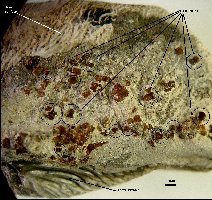 |
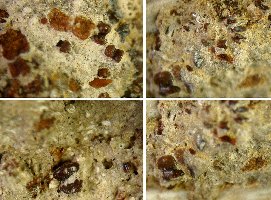 |
LEFT: Several micro-photographs of the
denticles discovered on the teeth. Denticles are about 0.5 to 1.5 mm in
length.
RIGHT: These are the most common of the denticles... they are
probably "dermal" denticles from the skin of the shark... called
shagreen, it is what makes shark skin feel like sand paper. |
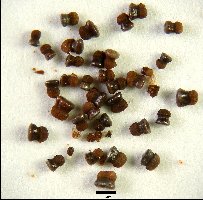 |
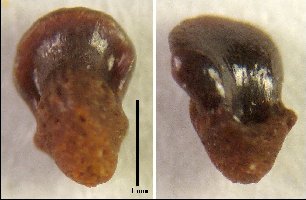 |
LEFT: A close-up of an oral denticles. These
larger denticles line the mouth and throat of the shark and help protect
it from sharp items in the shark's food.
RIGHT: The oral denticles are the largest of the ones that I have
found so far, but not nearly as numerous as the dermal denticles.
|
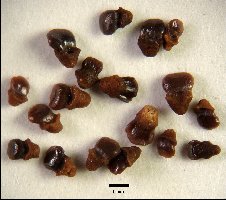 |
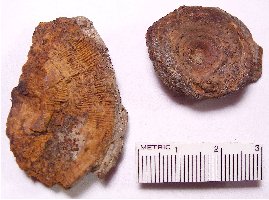 |
LEFT: There were only two vertebrae found in
the remains so far. The smaller one would have come from somewhere near
the tail. These vertebrae are very similar to those of Cretoxyrhina
and Squalicorax in appearance.
RIGHT: Two of the four large pieces of calcified cartilage that were
recovered. These are probably parts of the upper jaw or palatoquadrate. |
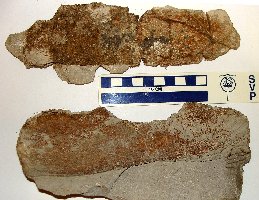 |
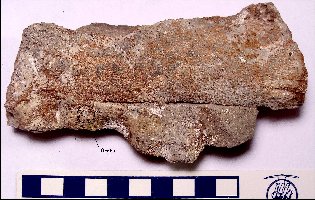 |
LEFT: Another large piece of calcified
cartilage. This piece was colonized briefly by an oyster (Pseudoperna
congesta - circle). While it may have been living in a rich
environment for a while when the shark's carcass was decomposing, the
oyster was probably smothered when it was covered up with silt.
RIGHT: A close-up of the oyster spat, surrounded by denticles
(black) and bits of cartilage (amber). |
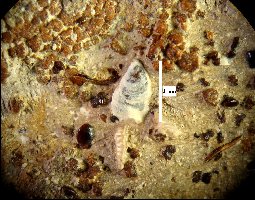 |
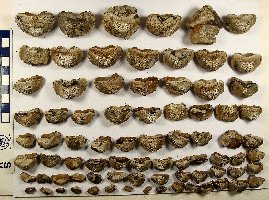 |
LEFT: A group photo of most the teeth that I
collected. These teeth probably come from the upper jaw. As of the end of
the initial clean-up and preparation, we had collected an additional 200
teeth.
RIGHT: These are replacement teeth that were in the process of being
formed when the shark died. In sharks, the enameloid crown forms first and
then the root is formed under it. There were about 50 replacement teeth
recovered with the specimen |
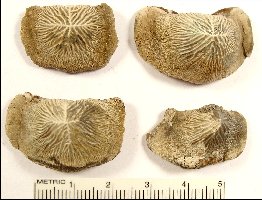 |
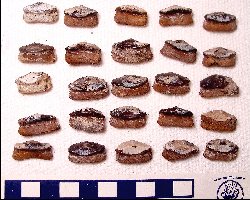 |
LEFT: Once I started sorting the smaller
teeth, I discovered more than 30 of these mesial teeth (center row of the
upper jaw)... This made the identification complete... we were working
with a single upper jaw of the shark... with about 550 teeth in
total. (Note that my conclusion has been questioned by other more knowledgeable
shark people)
RIGHT: A group of posterior lateral teeth that were preserved
in articulation. The crowns of the teeth are interlocked and arranged like
shingles on a roof... In this case, the teeth were at the back edge of the
upper jaw.
|
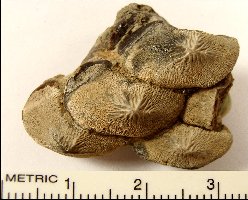 |
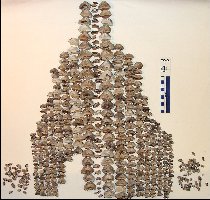 |
LEFT: My initial arrangement the teeth in the
upper jaw of this Ptychodus specimen. There are about 390 teeth in
the arranged portion with two groups of 50 posterior laterals on each
side. In life, there would be no spaces between the teeth in the jaw
plate... and the little mesial teeth in the center row would not be
visible (buried in gum tissue between the two rows of larger teeth.
RIGHT: My reconstruction of the upper jaw (palatoquadrate) with an
articulated jaw plate, in ventral view, and it's relationship to a
model of Ptychodus mortoni, based on: Shimada, K., Everhart,
M.J., Decker, R. and Decker P.D. 2010. A new skeletal remain of the durophagous
shark, Ptychodus mortoni, from the Upper Cretaceous of
North America
: an indication of gigantic body size. Cretaceous Research 31(2):249-254. |
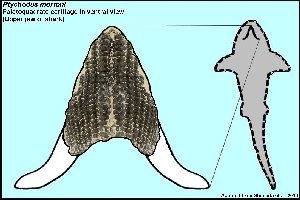 |
The specimen has been donated to the Sternberg Museum of Natural History
(FHSM VP-17606). Work on the site in June, 2011 did not recover any
additional remains.
Suggested references on Ptychodus in Kansas and around the world:
More
here on Ptychodus from the English Chalk
Agassiz, J. L. R. 1833-1844. Recherches sur les Poissons
Fossiles. 3: pp. vii + 390 + 32, Neuchàtel and Soleure.
Applegate, S. P. 1970. The
vertebrate fauna of the Selma Formation of Alabama; Part VIII, The Fishes. Fieldiana
Geology Memoirs 3(8):383-433, text figs. 174-204.
Cappetta, H.
1973. Selachians from the Carlile Shale (Turonian) of South Dakota. Journal of
Paleontology 47(3):504-514.
Cappetta, H. 1987. Chondrichthyes II - Mesozoic and Cenozoic
Elasmobranchii. Gustav Fischer Verlag, Stuttgart and New York. 193 p., 148 fig.
Case, G. R. and D. R. Schwimmer. 1988. Late Cretaceous fish from
the Blufftown Formation (Campanian) in western Georgia. Journal of Paleontology
62(2):290-301.
Case, G. R., T. T. Tokaryk and D.
Baird. 1990. Selachians from the Niobrara Formation of the Upper
Cretaceous (Coniacian) of Carrot River, Saskatchewan, Canada. Canadian
Journal of Earth Sciences 27:1084-1094.
ON LINE: Cicimurri, D. 2001. Cretaceous
elasmobranchs of the Greenhorn Formation (Middle Cenomanian-Middle Turonian), western
South Dakota. p. 27-43 in V. L. Santucci and L. McClelland (eds.), Proceedings
of the Sixth Fossil Resource Conference, Geologic Resources Division Technical Report,
NPS/NRGRD/GRDTR-01/01.
Cicimurri, D. J. 2004. Late Cretaceous
chondrichthyans from the Carlile Shale (Middle Turonian to Early Coniacian) of the Black
Hills region, South Dakota and Wyoming. The Mountain Geologist 41(1):1-16.
Cope, E. D. 1874.
Review of the Vertebrata of the Cretaceous period found west of the Mississippi River. U.
S. Geological and Geographical Survey of the Territories, Bulletin 1(2):3-48.
Cope, E. D. 1875. The
Vertebrata of the Cretaceous formations of the West. Report of the U. S. Geological Survey
of the Territories (Hayden). 2:302 pp., 57 pls.
David, M.L. 1996. Dental histology of Ptychodus and its implications in the
phylogeny of the Ptychodontidae, Journal of Vertebrate Paleontology 16(suppl. to 3):30A.
David, M.L. 1999. A histological and
mechanical description of Ptychodus. M.S. thesis, Fort Hays State
University, Hays, Kansas, 44 pp.
Dibley, G. E.
1911. On the teeth of Ptychodus and their distribution the English Chalk.
Quarterly Journal of the Geological Society of London 67:263-277, pls. 17-22.
Everhart, M. J.
2003. First records of plesiosaurs from the lower Smoky Hill Chalk Member (Upper Coniacian) of the Niobrara Formation of western Kansas.
Kansas Academy
of Science, Transactions
106(3-4):139-148.
Everhart, M.J. 2013.The Palate Bones of a Fish?” – The First Specimen
of Ptychodus mortoni (Chondrichthyes; Elasmobranchii) from Alabama.
Bulletin of the Alabama Museum of Natural History 31(1):98-104.
Everhart, M. J. and Caggiano, T.
2004. An associated dentition and calcified vertebral centra of the Late Cretaceous
elasmobranch, Ptychodus anonymus Williston 1900. Paludicola 4(4), p. 125-136.
Everhart, M. J., T. Caggiano, and K. Shimada. 2003. Note on
the occurrence of five species of ptychodontid sharks from a single locality in the Smoky
Hill Chalk (Late Cretaceous) of western Kansas. (Abstract) Kansas Academy of Science,
Transactions 22:29.
Everhart, M. J. and Darnell. M.K. 2004.
Occurrence of Ptychodus mammillaris (Elasmobranchii) in the Fairport
Chalk Member of the Carlile Shale (Upper Cretaceous) of Ellis County, Kansas.
Kansas Academy of Science, Transactions 107(3-4):126-130.
Evetts, M. J. 1979. Upper Cretaceous sharks from the Black Hills
region, Wyoming and South Dakota. The Mountain Geologist, 16(2):59-66.
Gibbes, R. W., 1848. Monograph of the fossil
Squalidae of the United States. Jour. Acad. Nat. Sci. Phila. Vol. 1, 2nd Ser., pt.
2, art. 12:139-147. pls. 18-21 (Ptychodus polygyrus).
Hamm,
S.A.
2010. The
Late Cretaceous shark, Ptychodus rugosus, (Ptychodontidae) in the
Western
Interior
Sea. Kansas
Academy
of Science, Transactions 113(1-2):44-55.
Hamm,
S.A.
2010. The Late Cretaceous shark Ptychodus
marginalis in the Western Interior Seaway, USA. Journal of Paleontology 84(3):538-554
Hamm, S. A. and M. J. Everhart. 1999. The occurrence
of a rare ptychodid shark from the Smoky Hill Chalk (Upper Cretaceous) of western Kansas.
Kansas Academy of Science, Transactions (Abstracts) 18:34.
Hamm, S. A. and K. Shimada. 2002.
Associated tooth set of the Late Cretaceous lamniform shark, Scapanorhynchus raphiodon
(Mitsukurinidae), from the Niobrara Chalk of western Kansas. Kansas Academy of Science,
Transactions 105(1-2):18-26. Hattin, D. E. 1982. Stratigraphy and depositional
environment of the Smoky Hill Chalk Member, Niobrara Chalk (Upper Cretaceous) of the type
area, western Kansas. Kansas Geological Survey Bulletin 225:108 pp.
Herman, J.
1977. Les sélaciens des
terrains néocrétacés et paléocenes de Belgique et des contrées limitrophes. Eléments
d’une biostratigraphique inter-continentale. Mémoires pour sérvir a l'explication
des Cartes géologiques et miniéres de la Belgique. Service Géoligique de Belgique, Mémoire 15, 401
pp.
Kauffman, E.
G. 1972. Ptychodus predation upon a Cretaceous Inoceramus.
Journal of Paleontology 15(3):439-444.
Leidy, J. 1868. Notice of American species of Ptychodus.
Proceedings of the Academy of Natural Sciences of Philadelphia 20:205-208.
Leidy, J. 1873. Contributions to the extinct
vertebrate fauna of the western territories. Report of the U.S. Geological Survey of the
Territories (Hayden), 1:358 pp., 37 pls.
Lucas, S. G., B. S. Kues, S. N. Hayden, B. D. Allen, K. K.
Kietzke, T. E. Williamson, P. Sealy, and R. Pence. 1988. Cretaceous stratigraphy and
biostratigraphy, Cookes Range, Luna County, New Mexico. New Mexico Geological Society
Guidebook, 39th Field Conference 143-167.
MacLeod, N. and B. H. Slaughter. 1980. A new
ptychodontid shark from the Upper Cretaceous of northeast Texas. The Texas
Journal of Science 32(4):333-335.
MacLeod, N. 1982. The first North American occurrence of the Late
Cretaceous elasmobranch Ptychodus rugosus Dixon with comments on the functional
morphology of the dentition and dermal denticles. Journal of Paleontology
56(2): 520-524.
Manning, E. M. and D.T. Dockery III. 1992. A guide to the Frankstown
vertebrate fossil locality (Upper Cretaceous), Prentiss County, Mississippi. Mississippi
Department Environmental Quality, Office of Geology Circular 4:43 pp., 2 pl.
Meyer, R.
L. 1974. Late Cretaceous elasmobranchs from the Mississippi and east Texas
embayments of the Gulf Coastal Plain. Unpublished doctoral dissertation, Southern Methodist University, Dallas, 400pp.
Morton, S. G., 1834. Synopsis of the organic remains of the
Cretaceous group of the United States. Key and Biddle, Philadelphia, 88 pp., 19 pl.
Morton, S. G. 1842. Description of some new species of organic
remains of the Cretaceous group of the United States; with a tabular view of the fossils
hitherto discovered in this formation. Journal of the Academy of Natural Sciences of
Philadelphia. 8:207-227, 2 pl.
Mudge, B. F. 1876. Notes on the Tertiary and
Cretaceous periods of Kansas. Bulletin of the U. S. Geological Survey of the Territories
(Hayden), 2(3):211-221.
Nicholls, E. L. 1988. New material of
Toxochelys latiremis Cope, and a revision of the genus Toxochelys
(Testudines, Chelonoidea). Journal of Vertebrate Paleontology 8(2):181-187.
Parkin, J. A., K.
Shimada, and B. A. Schumacher. 2002. Fossil fishes from the lowermost
Greenhorn Limestone (Upper Cretaceous: Middle Cenomanian) in southeastern Colorado. Paper
No. 187-15, Geological Society of American Annual Meeting.
Schwimmer, D. R.,
J. D. Stewart and G. D. Williams. 1997. Scavenging by sharks of the genus Squalicorax
in the Late Cretaceous of North America. Palaios 12:71-83.
Shimada, K. 1993. Upper Cretaceous elasmobranchs from the Blue
Hill Shale Member of the Carlile Shale, Western Kansas. Kansas Academy of Science,
Transactions 12(78).
Shimada, K. 1996.
Selachians from the Fort Hays Limestone Member of the Niobrara Chalk (Upper Cretaceous),
Ellis County, Kansas. Kansas Academy of Science, Transactions 99(1-2):1-15.
Shimada, K. 2012. Dentition of Late Cretaceous shark, Ptychodus mortoni (Elasmobranchii, Ptychodontidae). Journal of
Vertebrate Paleontology 32:6:1271-1284.
Shimada, K. and M. J. Everhart. 2003. Ptychodus
mammillaris (Elasmobranchii) and Enchodus cf. shumardi (Teleostei) from
the Fort Hays Limestone Member of the Niobrara Chalk (Upper Cretaceous) in Ellis County,
Kansas. Kansas Academy of Science, Transactions 106(3-4):171-176.
Shimada, K., Everhart,
M.J., Decker, R. and Decker P.D. 2010. A new skeletal remain of the durophagous
shark, Ptychodus mortoni, from the Upper Cretaceous of
North America
: an indication of gigantic body size. Cretaceous Research 31(2):249-254.
Shimada, K. and D. J. Martin. 1993. Upper Cretaceous selachians
from the basal Greenhorn Limestone in Russell Co., Kansas. Kansas Academy of Science,
Transactions 12:78.
Skelton, L. H. 1996. A brief
history of the Kansas Academy of Science. Kansas Academy of Science, Transactions
101(3-4):140-145.
Stewart, J.D. 1980. Reevaluation of the phylogenetic position of the
Ptychodontidae. Abstracts of Papers, Kansas Academy of Science, Transactions 83(3):154.
Stewart, J.D. 1988. Paleoecology and the first North
American west coast record of the shark genus Ptychodus. Journal of Vertebrate
Paleontology, 8:27A.
Stewart, J.D. 1990. Niobrara Formation vertebrate
stratigraphy. Pages 19-30, in S. C. Bennett, (ed.), Niobrara Chalk Excursion Guidebook.
University of Kansas Museum of Natural History and Kansas Geological Survey.
Welton, B. J. and R F. Farish. 1993.
The collectors guide to fossil sharks and rays from the Cretaceous of Texas. Horton
Printing Company, Dallas, 204 pp.
Williamson, T. E., J. I. Kirkland and S. G. Lucas. 1993. Selachians
from the Greenhorn cyclothem ("Middle" Cretaceous: Cenomanian-Turonian), Black
Mesa, Arizona, and the paleogeographic distribution of Late Cretaceous selachians. Journal
of Paleontology 67(3):447-474.
Williamson, T.E., S. G. Lucas and J. I. Kirkland. 1990. The
Cretaceous elasmobranch Ptychodus decurrens Agassiz from North America. Geobios
24(5):595-599.
Williston, S.W. 1900. Cretaceous fishes [of
Kansas]. Selachians and Pycnodonts. University Geological Survey Kansas VI pp.
237-256, with pls.
Woodward, A. S. 1887. On the dentition and affinities of the
selachian genus Ptychodus Agassiz. Quarterly Journal of the Geological Society
43:121-131, 1 pl.
Woodward, A.S. 1904. On the
jaws of Ptychodus from the chalk. Quarterly Journal Geological Society
London 60:133-136, 1 fig., pl. XV.
LINKS: Earliest
Ptychodus mortoni - A shell crushing shark from the
basal Fort Hays Limestone
Sharks teeth by the hundreds - A nearly
complete specimen of Ptychodus anonymus from Kansas
Ptychodus sharks teeth from around the world
including Ptychodus teeth from the English chalk.
Jim Bourdon's Ptychodus
pages - The Life and Times of Long Dead Sharks
Fort Hays Ptychodus mortoni - Earliest record
of this species in Kansas - Early Coniacian
NEW - Kansas Sharks - Kansas shark teeth from the Lower
Permian through the Upper Cretaceous.
More here on Ptychodus
from the English Chalk - Robert Randall's British Chalk Fossils web
site


















